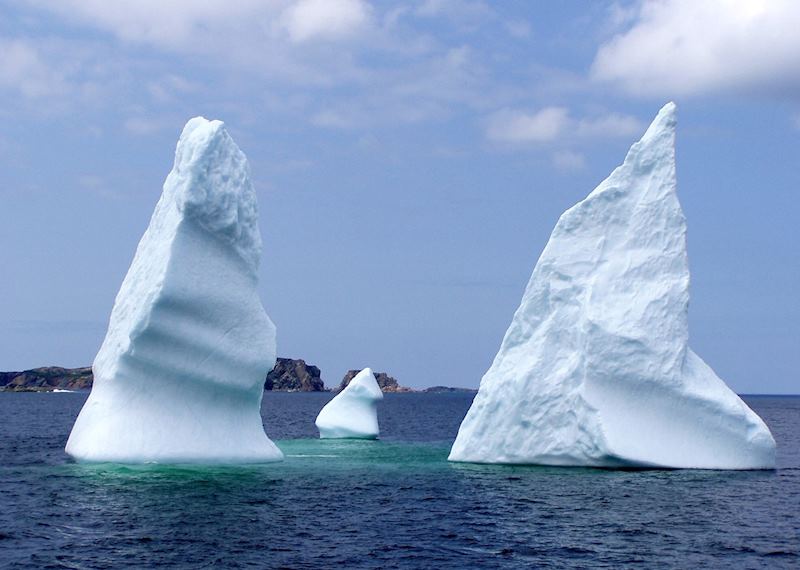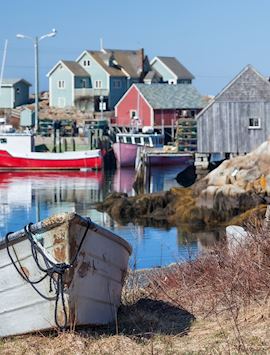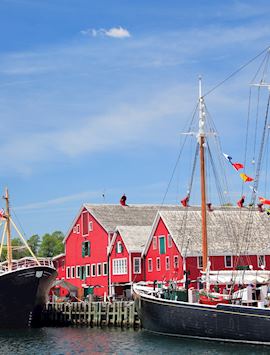By Canada specialist Jon
Atlantic Canada might be less well known than the Rockies or cosmopolitan Toronto, but I think this is a significant oversight. With its iceberg-strewn seas, vividly painted fishing communities, and distinct culture that blends Acadian French, Celtic, and Indigenous heritage, this region embodies an essence that’s entirely its own.
You might voyage to New Brunswick for extreme tidal ranges and the world’s greatest lobster concentration. Or, take the Confederation Bridge over to Prince Edward Island to relax on red-sand beaches of Anne of Green Gables. In Nova Scotia, there’s contorted shorelines, old-growth forests, and rolling orchards ideal for a road trip. And, in glacier-carved Newfoundland and Labrador, you’ll find deep fjords surrounded by sheer cliff faces. There’s so many opportunities to explore — to help you navigate this remote part of Canada, I’ve compiled a list of the highlights.
Pick your province
| New Brunswick | Prince Edward Island |
| Nova Scotia | Newfoundland & Labrador |
New Brunswick
The world’s highest tides, bays teeming with marine life, charming coastal towns, and a 300-year-old Francophone culture… New Brunswick promises you a diverse trip that blends natural beauty with a rich heritage entrenched in tradition.

Best for nature: the Bay of Fundy
A funnel-shaped body of water separating New Brunswick and Nova Scotia, the Bay of Fundy’s biggest claim to fame is its extreme tides, the highest in the world.
Hopewell Rocks is considered the best place to experience this phenomenon. When the tides are low, you can wander beside top-heavy sea stacks on a squelchy seabed festooned with seaweed and tidal life. Then, at high tide, kayak beneath those same rock formations, twisting and turning through small tunnels within the rockface.
Bordering the bay, Fundy National Park offers a network of hiking trails for you to explore further. To watch the tides sluicing back and forth from above, I suggest taking the Matthews Head trail to the coast. Or, you might journey into the park’s mossy boreal forests to see lichen-draped spruce trees and hidden river coves with curtain waterfalls.

Best for coastal town charms: Saint Andrews by-the-Sea
As one of Canada’s first seaside resorts, Saint Andrews by-the-Sea is a postcard-pretty town replete with brightly painted clapboard houses, whimsical murals, and boutiques selling crafts by local artisans.
I’d opt to spend a day or two wandering the town itself, from whitewashed Pendlebury Lighthouse to the well-manicured grounds at Kingsbrae Gardens. The weekly farmers’ market (every Thursday) is a highlight if you’re looking for local delicacies, or you could visit the wharf for fresh oysters by the sea. Walking over the ocean floor to the 19th-century estate on Ministers Island is another option at low tide.
Saint Andrews also serves as a gateway to the Bay of Fundy’s wealth of marine life. In terms of biodiversity, the waterway rivals the Amazon rainforest, and you can head out on a boat trip to observe humpback, minke and finback whales, as well as dolphins, bounding about its waters.

Best for culture: Fredericton
New Brunswick’s provincial capital, Fredericton, though a small city, is a thriving hub of historical buildings, local art, and diverse craft breweries.
Areas like Waterloo Row and Queen Street boast a trove of Victorian architecture, and you can visit the Old Government House for a glimpse into Canada’s early history.
Taprooms are a significant part of the culture, so I suggest hopping between a few breweries and cideries (such as York Country Cider) during your stay — or even coordinating your travels with the Down East Brew Festival in August.
Beaverbrook Art Gallery is another notable feature of the town’s cultural scene, showcasing both First Nations and modern Canadian art, as well as Salvador Dalí’s Santiago El Grande. And, for a dose of nature, you can walk over to leafy Odell Park or Bill Thorpe Walking Bridge for scenic views over the Saint John River.

Best for seafood: the Acadian Coast
The fishing settlement of Shediac proudly holds the title of “lobster capital of the world”. This is in part due to the giant lobster sculpture that sits as a prominent landmark on the town’s main street. But it’s mainly thanks to its crustacean-rich waters, a vital part of New Brunswick’s economy.
On a two-hour boat trip with a local fisherman, you can learn all about this environment, as well as how to fish for lobster, before enjoying your catch as a fresh meal back on shore. The lobster here is subtly sweet with an almost melt-in-your-mouth texture, and it pairs well with a crisp lager from local Pump House Brewery.
Shediac is also just one of many communities along the Acadian Peninsula. This wave-lashed shoreline is deeply rooted in Acadian French culture, which you can observe at Francophone ports like Caraquet or at the historical open-air museum Village Historique Acadien. In addition, parts of the area belong to the Indigenous Mi’kmaq territory, including Kouchibouguac National Park, where you can enjoy relaxing walks across salt marshes and quieter forest trails.

Prince Edward Island
Encompassing distinctive red sands, the nation’s most beloved fictional heroine, some of the world’s best seafood, and more lighthouses than you can shake a stick at, Prince Edward Island packs a passel of experiences — despite being Canada’s smallest province.

Best for history: Charlottetown
Known as the “cradle of Canadian Confederation”, Charlottetown, Prince Edward Island’s picturesque capital, is where modern Canada was born at a series of assemblies in 1864.
There’s no better place to dig deep into this history than at the Palladian-style Government House. I’m also a fan of nearby Beaconsfield House, which offers you a glimpse into the lives of the nineteenth century’s wealthy few with views out onto the waterfront.
You can take a sojourn down Richmond Street for more Victorian buildings, now repurposed as galleries and restaurants. And it’s worth a stop at St. Dunstan's Basilica, a neo-Gothic cathedral with pointy spires to rival its European cousins.
No guide to Charlottetown is complete either without mention of its food. The shellfish here is certifiably world-class, especially the premium Malpeque oysters, known for their briny-sweet taste. To really get your fill, take a tour around the city’s eateries with a local guide.
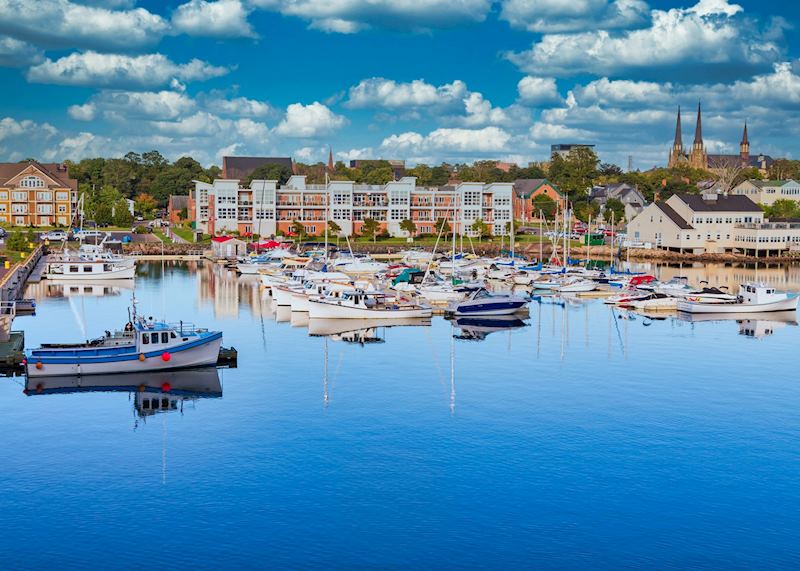
Best for fictional worlds: Cavendish
Red sandstone cliffs, rolling green fields, cerulean-blue seas, and soft yellow sands… It’s no wonder that the small community of Cavendish on Prince Edward Island’s north shore inspired the fictional town where Anne of Green Gables unfolds.
A farmhouse replicating Anne’s childhood home, Green Gables Heritage Place is worth a visit for its window into rural 19tht-century life — even if you’ve never read the books. There are also opportunities for you to stroll woodlands mentioned in the series, take part in interpretative experiences bringing the characters to life, and learn more about the author, L.M. Montgomery, in her family home nearby.
Afterwards, you might take a drive along the north shore, an area home to a wind-whipped coastline, coppery-red beaches, and a topsy-turvy constellation of lighthouses. West Point Lighthouse, with its distinctive black-and-white patterning, is a highlight stop among these.
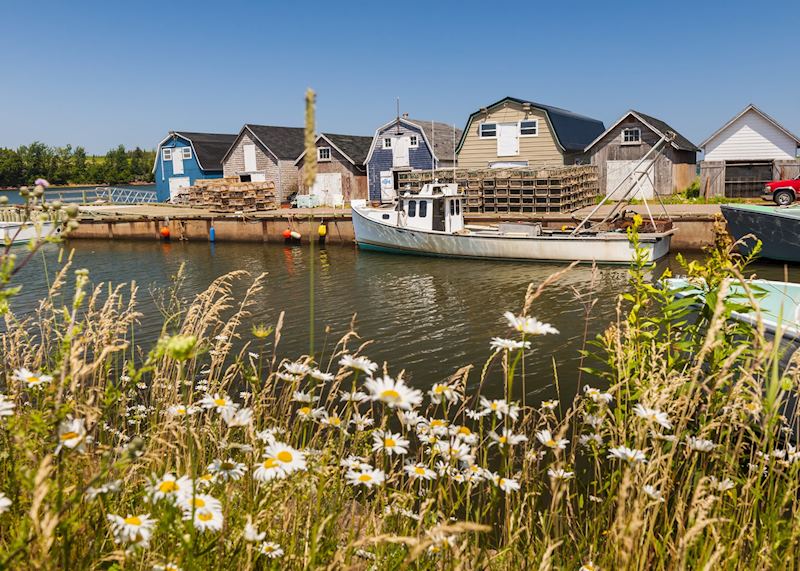
Best for beaches & lighthouses: Points East Coastal Drive
While the north might be celebrated for its windswept red-rock coast, I find there’s something equally inviting about the calmer, white-sand shores of Prince Edward Island’s east. By hiring a car, you can dip your toe into this slower-paced region on the Points East Coastal Drive.
I like to first stop at Greenwich’s horseshoe-shaped dunes. A “floating” boardwalk enables you to amble right next to them on one of the walking trails, before ending at Greenwich Beach’s silky shore.
It’s then worth a brief stop at East Point Lighthouse, the island’s most easterly point, before moving on to the star of the show: Basin Head Provincial Park. Also known as “Singing Sands Beach”, this ribbon of silica sands softly squeaks when you walk on it. Having some of the warmest waters in Canada, it’s an ideal swimming spot during summer as well.
Finishing up the route, take time to pause at Cape Bear Lighthouse, which was the first place to receive the Titanic’s distress signal.

Best for First Nations culture: Lennox Island
Prince Edward Island, like the rest of Canada, has a long-standing history of First Nations heritage, most notably that of the Mi’kmaq people. On Lennox Island, off the northwest coast, you can learn about this community’s culture and history through traditions passed down through the generations.
In one such experience, you can make a drum out of moose hide while listening about the drum’s significance to the Mi’kmaq. In another, you’re taught how to bake bannock (a type of flatbread) under the sand. There’s also art workshops run by the community, where you might make traditional items out of birch bark and porcupine quills.
For a further dose of cultural history, walk The Path of our Forefathers trail. On this 40-minute route, you’ll pass through green forests and bucolic blueberry fields, along the way reading about the island’s Indigenous past.

Nova Scotia
Named after Scotland, you can see why Nova Scotia reminded early Celtic settlers of their homeland. The province’s rocky headlands, strong maritime traditions, and skies full of migrating sea birds paint a picture not unlike the Scottish Highlands.

Best for a road trip: Cape Breton Island
With its knuckled shoreline, dense woodlands, and string of rustic fishing villages, Cape Breton Island is, in my opinion, the shining jewel of Nova Scotia’s proverbial crown.
The ultimate way to enjoy these landscapes is via the Cabot Trail, a coastal drive through Cape Breton Highlands National Park. Baddeck serves as a gateway to this route, and it’s worth sticking around town for placid Bras d’Or Lake’s waterfront eateries and boutiques.
I recommend following the trail east to west for unobstructed ocean views. For a secluded picnic, you can stop at North Bay Beach before cruising on to Ingonish, a cluster of villages shaped by Celtic influence.
As you travel north, the scenery gets even more dramatic, and there’s plenty of lookouts for a photobook-worthy picture. I like to sit on Lakies Head rock-side for the chance to see breaching whales, or head to North Mountain in autumn to gaze over the sweeping valley.
Ending your journey in Chéticamp, you’ll find a quaint fishing town steeped in Acadian French traditions. It’s also the starting point for the Acadian Hiking Trail, where I’ve seen eagles and even moose in the forest.

Best for waterfronts: Halifax to Lunenberg
Pick up any guidebook, and they’ll tell you that Halifax Harbour is one of the largest in the world. But what they might fail to mention is just how much is going on at this provincial capital’s historic waterfront. Beer gardens, museums, restaurants, and markets provide a thrumming atmosphere along the boardwalk, and you can cruise around on an all-electric, 1930s-style boat to learn more about its maritime history.
Drive 45-minutes south, and you’ll reach Peggy’s Cove, where brightly painted cottages line the shore. This area is best known for its traditional red-and-white lighthouse — said to be the most photographed in Canada. Views are best when the winds whip the waves over the smooth granite rocks.
I suggest also stopping at Mahone Bay. The town consists of hundreds of islets, the backdrop for a profusion of seabirds from puffins to great blue herons. Walking along the waterfront, take a look for the bay’s main attraction, three prominent churches sitting cheek by jowl.
Lastly, make a beeline for Lunenberg, one of Nova Scotia’s oldest towns and a designated World Heritage Site. Here, you’ll find vibrantly painted clapboard houses and moored sailboats clustered around the coastline, as well as the ruby-red Fisheries Museum of the Atlantic.

Best for wine: the Annapolis Valley
Canada might not be the first place you think of when it comes to wine, but the Annapolis Valley’s award-winning Tidal Bay whites are steadfastly making a name for themselves worldwide.
You can sample these crisp, aromatic, and slightly sweet wines at restaurants all over Nova Scotia, but to truly appreciate them I suggest visiting the wineries themselves. Most of the vineyards are dotted around the coastal town of Wolfville, where you might take a wine tour to fully maximise your visits, while also trying other culinary delights from the valley.
After your tour, consider visiting nearby Annapolis Royal, a historic town and waterfront. I love the candlelight graveyard tour, which takes place in Canada’s oldest cemetery every other day. It’s also home to Fort Anne National Historic Site, a well-preserved time capsule of early colonial military history.

Best for wildlife: Brier Island
Colonies of snoozing harbour seals sunbathing on basalt cliffs. Hungry gannets circling over surging blue waves. Porpoises darting through the sea in tightly knit pods. Another spot along the nutrient-rich Bay of Fundy, Brier Island is one of my all-time top places to see ocean life in Atlantic Canada.
By taking a whale watching boat tour around the island, you’ll have plenty of opportunities to look for marine life with the guidance of an onboard naturalist. Visit in summer, and you’ve got the best chances of seeing breaching fin, minke, and humpback whales, as well as razorbills, terns, and a whole host of other seabirds.
Back on land, you might also like to take a short hike to Balancing Rock, a towering basalt column that appears to be just barely balancing on the cliffside.

Newfoundland & Labrador
Newfoundland and Labrador might be part of Atlantic Canada, but crucially, unlike the other three, it’s not a Maritime Province — nor does it seem like one. Things are a bit different around here, from the iceberg-framed villages to the quirky pub traditions and the national park where you can literally walk on the Earth’s mantle.

Best for pubs: St. John's
Legend has it that St. John's, Newfoundland and Labrador’s portside capital, has the highest density of pubs per capita in North America. Whether that’s true or not remains to be seen, but there’s no denying the infectious vibrancy and hearty fare of the city’s establishments.
Venture into most of the pubs lining George Street and expect to see fiddlers performing traditional Irish jigs and sea shanties. This is also a popular location to be “screeched in”, a local rite of passage for newcomers to the province, which involves a short recitation, a “screech” shot (of rum), and the kissing of a cod.
When you’ve worked up an appetite, make your way to a local gastropub, where you might try Newfoundland specials like jiggs dinner (corned beef and cabbage) or fish and brewis (salted cod and hard bread).
To soak up some scenery beyond the pub walls, take a stroll beside Jellybean Row’s pastel-painted houses or hike up Signal Hill to get a birds-eye view of the bay. You can also drive down to the fishing community of Quidi Vidi and stop by the heritage-listed Mallard Cottage.

Best for landscapes: Gros Morne
The thunderous waterfalls, glacier-carved escarpments, and glittering fjords of UNESCO World Heritage Site Gros Morne National Park provide a thrilling backdrop for outdoor activities unlike anywhere else in Canada.
While there, I’d find time for a guided hike to learn more about how this geologically diverse land was formed. On the tour, you summit Gros Morne Mountain for sweeping views across a sparkling fjord, before proceeding to the tablelands. Here, you’ll step on the vegetationless grounds of the Earth’s mantle — exposed in a collision of tectonic plates millions of years ago.
A boat ride down Western Brook Pond is another must-do in Gros Morne. This landlocked fjord, sculpted by ancient glaciers, paints a dramatic picture with its cascading waterfalls, glassy blue waters, and occasional mossy cliff faces.
The park shelters a plethora of Canadian wildlife from caribou to arctic hare to the ever-flitting Canada jays. But it’s probably best known for its moose — they say there’s more here than anywhere else in the world.
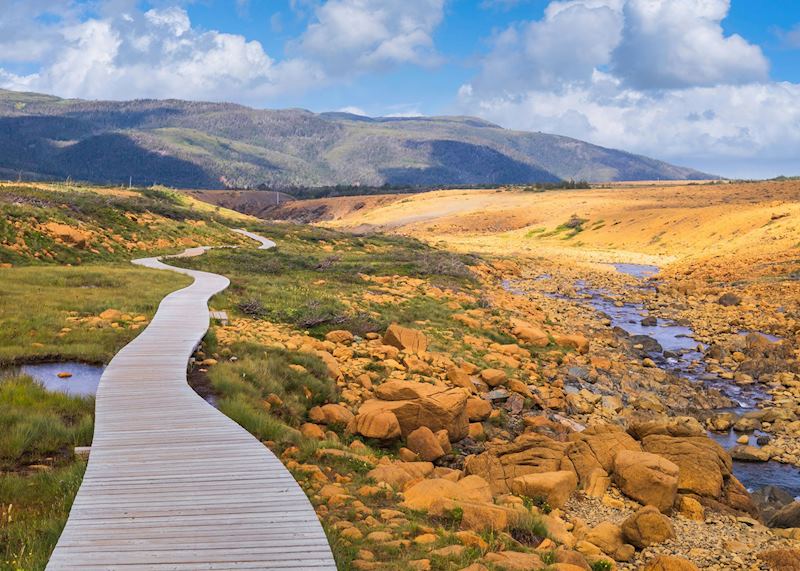
Best for whale watching: Trinity Bay & Bay Bulls
There’s plenty of reasons to visit Trinity Bay. The abandoned fishing villages. The green hills punctuated by ponds. The well-preserved town of Trinity with its spired chapel, modern galleries, and saltbox houses (where you can stay overnight). The undeniable stars of the show, though, are the whales — and you’re likely to see many of them, especially in summer.
Picture the scene. You’re zipping through the bay’s cold, vigorous waters passing wave-worn sea caves and even the occasional iceberg. Then captain cuts the engine. A few seconds pass before a geyser of mist erupts from the sea. There’s a tremor and — suddenly — a flash of black as a humpback whale launches itself out of the ocean. Imagine that, over and over again, but it’s not just humpbacks, it’s fin and sperm whales too. Some of them moving in multigenerational packs.
Only around Bay Bulls, near St. John's, have I seen similar numbers of cetaceans. During summer, nearby Gull Island is also renowned for its thriving puffin population. (It’s part of the Witless Bay Ecological Reserve, which is the largest puffin colony in North America). See them darting around the skies and burrowing into the earth on an educational catamaran trip out of the bay.

Best for iceberg spotting: Twillingate & Fogo Island
Twillingate and the surrounding areas are an otherworldly experience. You’ll be sitting in a small coastal village, populated by only a few thousand — if not hundred — people, and a mountain of floating ice will be looming in the background.
The area is part of Iceberg Alley, a slice of sea where massive ice chunks calved from Greenland’s glaciers drift through late spring and early summer. The icebergs are visible from land, of course, but the views from the sea are incomparable. By boat, you can get up close and listen to the bergs crackle, pop, and crash into the water, as well as look for the marine life that gathers around them.
A short drive and ferry ride from Twillingate takes you to another great location for icebergs, Fogo Island. The isle is best known for its luxe, artistically conceived inn — sitting on a cliff’s edge, it offers far-reaching ocean views. However, it’s worth exploring even without a room, for a level of remoteness that surpasses even Canadian standards.
